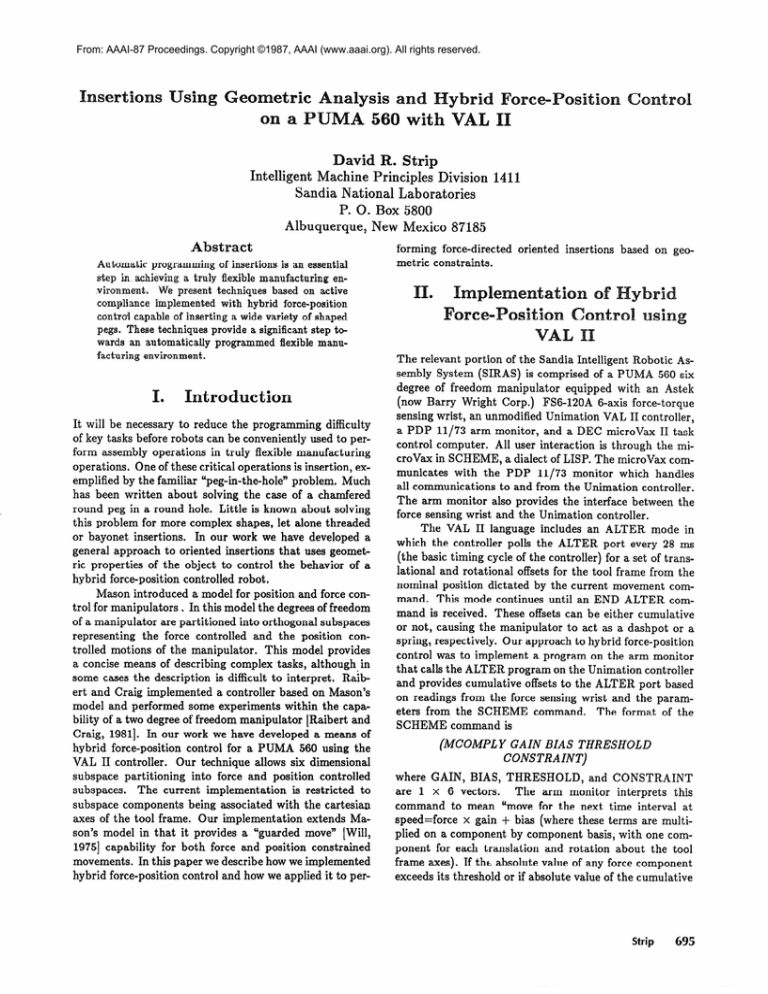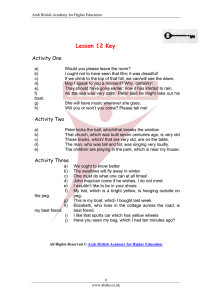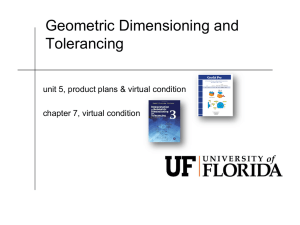
From: AAAI-87 Proceedings. Copyright ©1987, AAAI (www.aaai.org). All rights reserved.
sestions
using
Geometric
Analysis
an
1
A 560 with
David R. Strip
Intelligent Machine Principles Division
San&a National Laboratories
P. 0. Box 580Q
Albuquerque,
New Mexico
Abstract
Automatic programming of insertions is an essential
step in achieving a truly flexible manufacturing environment. We present techniques based on active
compliance implemented with hybrid force-position
control capable of inserting a wide variety of shaped
pegs. These techniques provide a significant step towards an automatically programmed flexible manufacturing environment.
It will be necessary to reduce the programming difficulty
of key tasks before robots can be conveniently used to perform assembly operations in truly flexible manufacturing
operations. One of these critical operations is insertion, exemplified by the familiar “peg-in-the-hole” problem. Much
has been written about solving the case of a chamfered
round peg in a round hole. Little is known about solving
this problem for more complex shapes, let alone threaded
or bayonet insertions. In our work we have developed a
general approach to oriented insertions that uses geometric properties of the object to control the behavior of a
hybrid force-position controlled robot.
Mason introduced a model for position and force control for manipulators . In this model the degrees of freedom
of a manipulator are partitioned into orthogonal subspaces
representing the force controlled and the position controlled motions of the manipulator. This model provides
a concise means of describing complex tasks, although in
some cases the description is difficult to interpret. Raibert and Craig implemented a controller based on Mason’s
model and performed some experiments within the capability of a two degree of freedom manipulator [Raibert and
Craig, 19811. In our work we have developed a means of
hybrid force-position control for a PUMA 560 using the
VAL II controller. Our technique allows six dimensional
subspace partitioning into force and position controlled
subspaces. The current implementation is restricted to
subspace components being associated with the Cartesian
axes of the tool frame. Our implementation extends Mason’s model in that it provides a “guarded move” [Will,
19751 capability for both force and position constrained
movements. In this paper we describe how we implemented
hybrid force-position control and how we applied it to per-
1411
87185
forming force-directed
metric constraints.
oriented insertions based on geo-
The relevant portion of the Sandia Intelligent Robotic Assembly System (SIRAS) is comprised of a PUMA 560 six
degree of freedom manipulator equipped with an Astek
(now Barry Wright Corp.) FS6-120A 6-axis force-torque
sensing wrist, an unmodified Unimation VAL II controller,
a PDP 11/73 arm monitor, and a DEC microVax II task
control computer. All user interaction is through the microVax in SCHEME, a dialect of LISP. The microVax communicates with the PDP 11/73 monitor which handles
all communications to and from the Unimation controller.
The arm monitor also provides the interface between the
force sensing wrist and the Unimation controller.
The VAL II language includes an ALTER mode in
which the controller polls the ALTER port every 28 ms
(the basic timing cycle of the controller) for a set of translational and rotational offsets for the tool frame from the
nominal position dictated by the current movement command. This mode continues until an END ALTER command is received. These offsets can be either cumulative
or not, causing the manipulator to act as a dashpot or a
spring, respectively. Our approach to hybrid force-position
control was to implement a program on the arm monitor
that calls the ALTER program on the Unimation controller
and provides cumulative offsets to the ALTER port based
on readings from the force sensing wrist and the parameters from the SCHEME command. The format of the
SCHEME command is
(MCOMPLY
GAIN BIAS THRESHOLD
CONSTRAINT)
where GAIN, BIAS, THRESHOLD, and CONSTRAINT
are 1 x 6 vectors.
The arm monitor interprets this
command to mean “move for the next time interval at
speed=force x gain + bias (where these terms are multiplied on a component by component basis, with one component for each translation and rotation about the tool
frame axes). If tht absolute value of any force component
exceeds its threshold or if absolute value of the cumulative
Strip
695
a. Approach
c. One Point Contact
b. Chamfer
Crossing
d. Two Point Contact
Figure 1: Stages in Insertion
movement exceeds the constraint, end alter and return a
completion signal.” In our implementation a 0 value for any
component in the threshold or constraint vectors implies
unlimited threshold or constraint.
This implement at ion provides a full six degrees of freedom of hybrid force-position control. It assumes, however,
that forces and torques can only affect translations and
rotations about the axis with which the force or torque is
associated. A more general implementation in which the
gain vector is replaced by a full 6 x6 (accommodation) matrix would allow forces and torques to have effects off their
natural axis. This more general implementation would allow solutions such as Starr’s edge following, which was also
based on the VAL ALTER command [Starr, 19861.
III.
Application
to the Peg in the
ole Problem
Whitney provides an analysis of the forces and torques encountered during the various phases of the insertion of a
round peg into a chamfered hole [Whitney, 19821. Whitney’s analysis provides the means for establishing the design parameters of a remote center compliance (RCC), a
device for providing passive compliance on an otherwise
rigid manipulator.
A program for performing the peg-in-the-hole task was
written using the hybrid force-position control command
described above. With the peg positioned above the hole
(Figure la) by means of a vision system, the arm is given
the command
speed of lOmm/sec in the positive z-direction only. On encountering the chamfer (Figure lb) the sensor will see xand y-forces (and in practice also small torques) that when
multiplied by the gains will cause the peg to translate towards the center of the hole. As the peg drops into the hole
(Figure lc) any binding will create a z-force which, when
multiplied by the gain, will slow the insertion rate while the
associated torques about the x- and y-axes will cause the
peg z-axis to tilt into alignment with the axis of the hole.
When the peg hits the bottom the z-force should build up
to -10 Newtons, which, when multiplied by the gain, would
negate the bias and cause the arm to stop moving without exceeding the threshold. In a well-behaved system the
program’s stopping criterion would not be reached and the
arm would appear to be “hung.” Because the VAL II controller only samples the ALTER port every 28 ms and the
force sensing wrist samples at 16 ms intervals there can be
a considerable lag between the time a force measurement
is made and the time it impacts the arm movement. This
time delay combined with the stiffness of the arm requires
that the z-threshold in our demonstration be 30 Newtons,
although a threshold of less than 10 Newtons would be required to achieve the stopping criterion in a well behaved
system. This threshold value always succeeds in stopping
the system, contrary to intuition, although it does occasionally allow the peg to “bounce” one or two times at
the bottom of the hole when the z-velocity is such that
it hits bottom with greater than 10 Newtons force, which
causes a negative z-velocity, but less than the 30 Newtons
stopping threshold. These characteristics of the implementation demonstrate the limitations of implementing force
controlled manipulation using commercial parts linked by
software. Because the manipulator controller and the force
sensor are not synchronized and operate at different sampling rates, the time lag from sensing to action is a random variable. The stiffness of the arm and workpiece are
such that unless one is willing to perform the task at extremely low rates of movement (under lmm per second
z-travel), it is not possible to analytically develop the parameters for the MCOMPLY command given an analysis
of the problem. An additional limitation in applying this
force-position control technique is the inability to rotate
the reference frame of the force sensor. While the reference frame can be translated to a new location, it cannot be rotated. Since the implementation is constrained
to programs with independent effects on all the axes, an
ability to rotate the reference frame would allow the solution of problems that can be represented by orthogonal
force-position programs, but which are not aligned with
the natural axes of the force sensor reference frame.
riented
(1 11 .Ol-01.Ol)(0 0 10 0 0 0)
(0 0 so 0 0 o)(o0 0 0 0 0))
(MCOMPLY
The force sensor and the tool frame origins are both translated to the center of the bottom of the peg. This set of
gains and biases commands the peg to move at a nominal
696
Robotics
RCCs provide a practical means of performing insertions
using a single robotic motion and without the use of precision jigs. It does not appear to be practical (or, in some
cases, possible) to generalize the RCC design to allow insertion, in a single robotic motion, of unchamfered round pegs
or pegs which are not round in cross section and therefore
require orientation.
A multi-stage strategy for performing oriented insertions was developed based on observation of human strategy for the same task. The underlying principle of using
constraints imposed by the geometry of the object is shared
with the approach used by Shariat, Coifeet, and Fournier
to plan a strategy for an inaccurate, flexible robot [Shariat
et al., 19851. This strategy is based on the assumption that
the objects being inserted are “large” in comparison to the
scale of error in the vision and manipulator systems. If
this does not hold, it would not be possible to determine
orientation information about the object from the vision
system and manipulation would require an entirely different approach.
The multi-stage strategy consists of three steps; approach, orientation, and insertion. In the approach step
the “peg” is brought into contact with the block containing the hole. In making this approach the peg is oriented
to match the orientation of the hole within the limits of
the vision system and the manipulator. (In a factory environment these locations may be known through the use
of jigs. The adaptability of the technique, however, would
allow the use of fairly low precision (and thus low cost)
jigs in contrast to traditional high tolerance jigging techniques.) In our laboratory this amounts to about l/4 inch
linear displacement and 4 or 5 degrees angular displacement. In bringing the parts into contact the peg is deliberately shifted to insure a “target point” of the object
is over the hole. For an object like the isosceles triangle
shown in Figure 2, this point is the corner with the sharpest
angle. (There is more discussion of how to select this point
later.) The object is then tilted into the hole as shown in
Figure 2a. This ends the approach stage. The first stage
of the insertion does not require compliance, active or passive, although force sensing may be used to simplify the
programming of the approach since contact forces may be
used to detect that the peg has contacted the block.
The orientation stage is broken down into two parts.
During the first part the target point is driven towards its
matching point in the hole. If the target point has been
properly selected, active or passive compliance combined
with the appropriate manipulator motion will move the
point of the peg into the corner of the hole. The peg will
rotate to approximately the correct orientation due to the
torques on the peg from the contact with the side of the
hole (Figure 2b). In the second part of the orientation
step the peg is rotated about a line through the target
point and perpendicular to the direction of travel into the
corner. This rotation will return the peg to an approximately vertical position (Figure 2~). If this rotation is
made compliantly with constant force maintained between
the target point of the peg and the corner of the hole, the
lower edge of the peg will (in general) meet the edges of
the hole at an angle, introducing a torque on the peg that
Side View
(Cut Though Center)
Top View
~
,~
..;.....:,.v.:.,: L
a. Approach
b. Orientation
C. Orientation
- Stage
1
- Stage 2
Figure 2: Stages in Oriented Insertion
will further correct its orientation.
The insertion stage for orientable objects is the same
as the final stage of insertion for round pegs as analyzed
by Whitney and described in Section III. [Whitney, 19821.
A program using this strategy was implemented in
our laboratory using the hybrid force-position control technique described above. The use of hybrid force-position
control instead of passive compliance encourages us to
learn about the forces involved in the insertion process and
leads to a more general understanding than we might get
using passive compliance devices. In addition, the error
of our vision system (particularly with respect to determining orientation angle) is greater than the travel limits
of commercial RCCs known to us and therefore precluded
their use without some form of active compliance. Figure 3
shows the variety of peg shapes successfully inserted with
this insertion program. By using hybrid force-position control a single program can be used to perform insertion
of a wide variety of shapes. While conceptually similar
to the approach in [Shariat et al., 19851, the use of hybrid force-position control (even for an inaccurate flexible
robot) considerably simplifies the implementation of the
insertion technique and allows an identical program to insert a variety of shapes. Hybrid force-position control also
allows the programmer control over the forces exerted on
the workpieces, which can be critical when manipulating
fragile objects.
Strip
697
In related research we are examining the role of active
versus passive compliance and the requirements for controllers to provide hybrid force-position control. We are
also examining the potential for fine control at the end of
the manipulator to perform the small movements required
in insertions, rather than relying on moving the entire manipulator. In this vein we have mounted a Salisbury hand
on a PUMA 560 robot, operating the hand in hybrid forceposition control using a controller built in our lab. We are
developing a dextrous end-effector based on our experiences with the Salisbury hand that will provide for fine
movements, but with reduced degrees of freedom relative
to the Salisbury hand to simplify control.
eknow
gements
I would like to acknowledge the efforts of Greg Starr, who
developed the concept for hybrid force-position control using the VAL-II ALTER command and provided the first
implementation, and Bill Davidson, who implemented the
improved version of the hybrid force-position control used
in our lab.
Figure 3: Shapes Successfully Inserted
v.
electing
the
rget
eferences
oil-It
In the section above we referred to a “target point” that
was central to all the stages but did not explain how to
select such a point. Humans have an intuitive understanding that allows them to select this point without conscious
thought. In order to have our robot select these points,
we need to understand their properties. The key role of
the target point is to induce torques and forces on the peg
from its contact with the edge of the hole. These torques
and forces should be such that when the peg is rotated or
translated to zero out these forces and torques as the target point approaches its corner in the hole, the orientation
of the peg should move to alignment with the hole. For
convex polyhedral objects the point with the smallest interior angle appears generally to be a good choice. A good
target point for a convex object with a smooth boundary
is the point with the smallest radius of curvature.
VI.
Future
Work
We have several directions in which we are taking these
results. We would like to be able to automatically determine the “target point” and insertion strategy from a
description of the object to be inserted. We want to be
able to prove that a given technique is necessary and/or
sufficient for performing insertions. Automated assembly
will require the insertion of threaded and bayonet parts.
Small parts (small relative to the scale of the manipulator and vision system accuracy) and parts with extremely
tight tolerances will have to handled. We are working in
each of these areas to develop a complete capability for
automated insertions.
Robotics
[Mason, 19811 M. T. Mason, “Compliance and Force Control for Computer Controlled Manipulators,” IEEE
Bans. Systems, Man, and Cybernetics, Vol. SMC-11,
No. 6, June 1981.
[Raibert and Craig, 19811 M. H. Raibert and J. J. Craig,
“Hybrid Force-Position Control of Manipulators,”
Trans. ASME J. Dynamic Systems, Measurement,
and Control, Vol. 102, No. 2, June, 1981.
[Shariat et al., 19851 B. Shariat, P. Coifeet, and A.
Fournier , “A Strategy to Achieve an Assembly by
Means of an Inaccurate, Flexible Robot,” Computing Techniques for Robots, Chapman and Hall, N.Y.,
N.Y., 1985.
[Starr, 19861 G. P. Starr, “Edge Following with a PUMA
560 Manipulator Using Val-II,” Proc. IEEE Int’l
Conf. Robotics and Automation, San Francisco, CA.,
April, 1986.
[Whitney, 19821 D. E.
bly of Compliantly
ASME J. Dynamic
trol,, Vol 104, No.1,
Whitney, “Quasi-Static AssemSupported Rigid Parts,” Trans.
Systems, Measurement, and ConMarch, 1982.
[Will, 19751 P. M. Will, and D. D. Grossman, “An Experimental System for Computer Controlled Mechanical
Assembly,” IEEE Trans. Comput., Vol. C-24, No. 9,
Sept., 1975.





